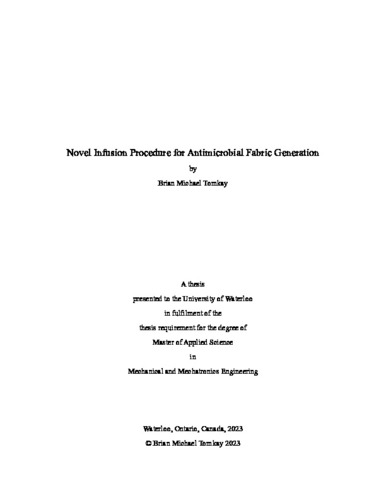| dc.description.abstract | Antimicrobial fabrics are fabrics that can kill or slow down the growth of microorganisms that contact the fabric. It is a massive field that is developing due to the sheer variety of fabrics that are possible. Antimicrobial fabrics contain active (antimicrobial compounds) such as organic molecules, metals, or antimicrobial peptides. The variety in antimicrobial fabrics comes from the ability to combine and use the antimicrobial compounds to create a fabric finish with unique properties. Therefore, various properties can be explored to determine the best usage case for the fabric.
I created a novel antimicrobial infusion fabric nicknamed “Beryl” together with its production process. In collaboration with engineers Microbonds Inc., Markham, Canada. This fabric is based on a standard woven cotton subject to a pre-infusion (pretreatment) of a solution containing an organic acid, a polymer, and a surfactant. This fabric is then subject to a main infusion with various ppm levels of cupric (Cu2+) ions. These successive infusions impart antimicrobial properties to the fabric.
Described in this thesis are the physical and antimicrobial properties of this new fabric. The fabric is compared to a previous proprietary fabric from Microbonds Inc, named AC5, as well as a control fabric treated with copper sulfate. Characterization begins with the fabric feel and odor, which remained unchanged. Color change was measured using a PICO paint matcher device, which showed that the Beryl fabric maintains the original color of the fabric better than the AC5 fabric. The copper content of the fabric was tested, showing that the Beryl had typically between 0.357 and 6.43 mg of copper per gram of fabric. Fabric morphology was determined using a scanning electron microscope, which showed the Beryl fabric contained a thin coating of copper on the surface of the cotton fibers, with only a few small copper deposits at some exposed locations on the fabric fibers. In contrast, the AC5 fabric showed a discontinuous, seemingly brittle but thick layer of copper, with larger deposits at multiple locations on the surface of the fabric. The thin layer of copper for the Beryl was confirmed using energy dispersive x-ray spectroscopy, despite it not being visible in the backscatter electron detector image. Antimicrobial efficiency tests were done before and after multiple wash cycles to show laundering resistance of the antimicrobial coatings. It was found that the fabric was perfectly efficient at 0 washes, while after 30 washes, the fabric’s efficiency dropped to 96 % for the 1000 ppm copper infused Beryl fabric. The antimicrobial properties of the pre-infusion were also tested showing the fabric was effective at 0 washes. Plates incubated for longer suggest Beryl is bacteriostatic at 30 washes rather than bactericidal. Contact time efficiency tests showed that the fabric reduced bacterial load within 45 seconds, with 100 % efficiency reached after 5 minutes of contact time with the fabric.
After laundering, the efficiency for the Beryl decreased below that of the AC5 fabric. However, by increasing the copper ion content of the cupric ion infusion bath, the wash resistance of the fabric can be expected to increase to maintain 100 % efficiency, so it retains effectiveness after larger numbers of washes. Furthermore, usage of the Beryl process is safer, making it more sustainable than the AC5 due to no hazardous gaseous products being created in the Beryl process. | en |

